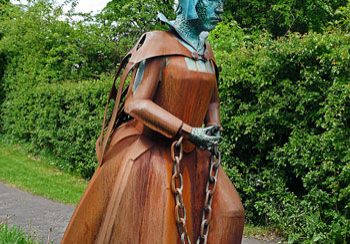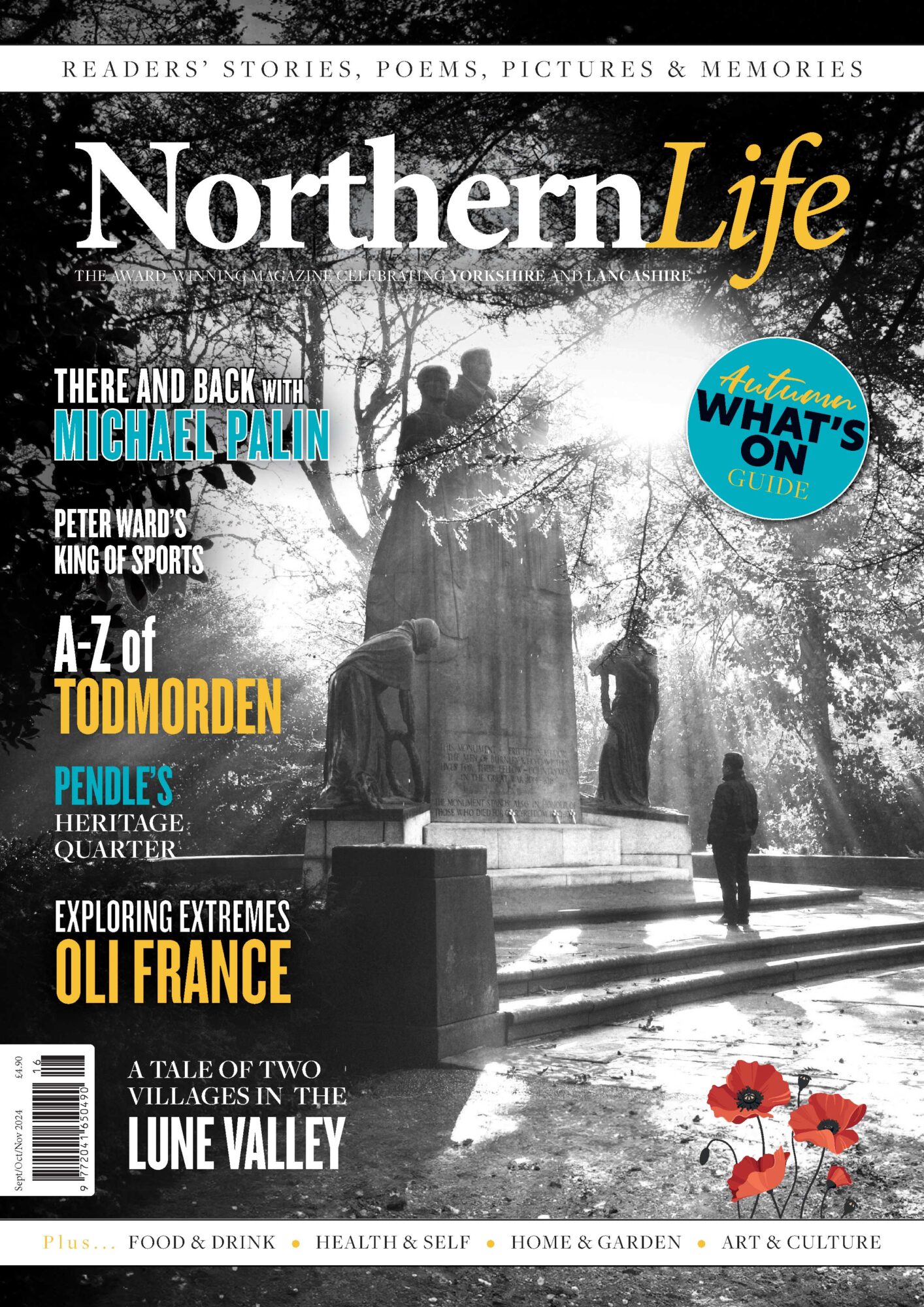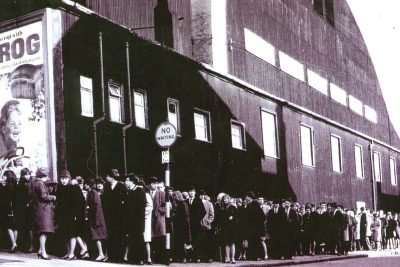
ALICE NUTTER: Lancashire’s first social worker?
by Northern Life

Statue of Alice Nutter. Photo by Hornbeam Arts
By Mike Roberts
On a warm spring morning in 2011 the Burnley local historian, Steve Chapples and I, set off on a journey to Slaidburn. For more than a decade what we called our ‘Magical History Tours’ had provided us both with stimulating research and many good afternoons out in the north west. Steve was considering writing an article on the so called ‘Pendle Witches’ for the popular magazine Northern Life for which he had been a prolific contributor for a number of years. The central subject of this piece of research was Alice Nutter. Stopping off at the ancient inn, ‘Hark to Bounty’ in Slaidburn to view the court room upstairs for further inspiration we began a conversation that has resulted in this article. At some point in the afternoon we both came to the conclusion that the story surrounding that of Alice Nutter seemed riddled with anomalies. Steve later that autumn presented some of his early research to the Burnley History Society. Sadly Steve was unable to complete his article, his failing health and sudden demise in January 2014 ended his blossoming career as a notable Burnley historian that had already led to a number of publications and even appearances on BBC television.
Putting aside all the usual interpretations involving the ridiculous fabrications around witches and witchcraft Steve wanted to investigate more deeply into the lives of the victims of the hysteria of 1612. It all began by looking at the historical context and the livelihood of the two main characters. Steve was not convinced that these elderly women were essentially poor.

Stopping off at the ancient inn, ‘Hark to Bounty’ in Slaidburn
Although Elizabeth Southern was in her eighties and blind, her widowed daughter, Elizabeth Device, along with her three children, Alizon, James and Jennet may more correctly be recognised as part of an extended family that had fallen on hard times. In 1612, with the demise of the monastic system in the north, the administration of social welfare came under the terms of the Elizabethan Poor Law Act of 1601 which placed the responsibility for taking care of the poor on the parish of their birth. No church warden’s accounts for the rendering of Parish Relief exist to testify how long this family were classified as ‘in want of relief ’ or registered as paupers.
Added to this many people living in the Pendle Forest area still practiced the old religion; Roman Catholicism remained in the hearts and minds of the populace despite the destruction of the country’s earliest places of refuge for health and social care. In previous centuries looking after the poor, health care and the dispensing of medicines were within the duties and domain of the monasteries. These true Christian religious centres, the monasteries and abbeys of the Dominicans and Cistercians were an integral part of medieval society but were plundered and destroyed in the dissolution during the period of the Reformation and their assets utilised by the tyrant King Henry VIII. Retribution for Lancashire’s part in the ‘Pilgrimage of Grace’ in 1536 was swift and brutal. This popular protest march from the north resulted in both the Abbot of Whalley, John Paslew and the Abbot of Sawley, William Trafford, being executed for their part in this brave act of defending the faith that Henry himself had sworn to defend. Both Abbots were executed in 1537. The atrocities committed by this rogue king often go unnoticed due to the emphasis paid in history books to Henry’s desperate and often insane quest for a son and heir.
Although a commercial rival in the art of healing to Elizabeth Southern, Ann Whittle (or Chadwick) had been an old friend when she attended the crisis meeting at Malkin Tower on that Good Friday in 1612. From then on this is a story of false accusations and serious miscarriages of justice brought to bear on a group of innocent people.
Steve had begun his research by investigating the ‘cures’ that may have been used by these women as rudimentary medicines. There was possibly a line of continuity in their origins linked to the religious centres of the old religion. Even today many of these fungi, herbs and common weeds can be found in the hedgerows and woodlands of the Pendle Forest. Side effects, wild dreams and hallucinations sometimes with adverse reactions can result even from modern medicines. In the 17th century more precarious concoctions derived from common herbs could on occasions prove useful or they could exacerbate a condition sometimes even proving fatal. Yet some common plants such as Foxglove found easily in the Pendle area can still provide modern medicines for heart conditions. One of the main conclusions reached by Steve was that in the year 1612 locally distilled or brewed alcohol and mind altering substances were more common than we could imagine. After all there was no quality control of drinking water and the safest liquid to drink was probably one that had been boiled or distilled. Into this very different world appears a good Christian woman named Alice Nutter. It seems that Alice Nutter was some years younger than her friend Elizabeth Southern and possibly finding life much easier at that time.
The main conclusion derived from Steve’s investigations was that in 1612 Alice Nutter was acting in the capacity of a woman that today we would recognise as a social or charity worker. He believed that the crisis meeting that gathered at Malkin Tower on Good Friday in 1612 had nothing to do with witchcraft. This was mere fabrication. The significance of the date suggests that this was more in keeping with a Christian religious gathering and likely to incorporate the charitable act of food sharing at the end of a long hard winter. Easter is celebrated at a time in the agricultural year when food supplies would be at their most depleted amongst these families. The date is very significant. Good Friday is not associated with any pagan festival other than one occurring on the Christian calendar. There is also speculation that a Roman Catholic priest might have attended on that date to give the sacrament at Malkin Tower. Therefore for the sake of the sanity of our children it would be better if the whole notion of witchcraft were dismissed completely out of hand and a more sensible focus was brought to bear on the religious circumstances of the time and the despicable persecution of old women and their poor families must be seen for what they must surely have been, namely fabrications, manipulation, superstition and bigotry. Looking after the poor of the parish would have been a burden on the gentry of the village and most likely to be onerous to some minds whose families had taken advantage of the selling off of valuable church lands in previous decades. Demonisation of the poor is also a modern phenomena and unscrupulous minds can easily stir up myths and irrational argument.
Anyone turning to Samuel Pott’s record of the trial of these falsely accused women and men would enable the reader to gain some insight into the inadequacy of the judicial system in 1612. The story would be farcical if it were not so tragic. Alice Nutter went silently to the scaffold in Lancaster her story largely untold perhaps until now by a Burnley local historian of fond memory.




